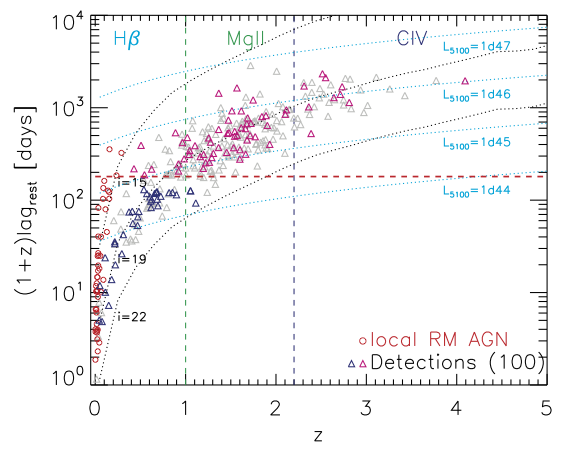Summary
The SDSS-V/BHM Reverberation Mapping (RM) project seeks to measure the time lag of broad emission line response to continuum variability, and hence virial BH mass estimates, aiming for a large and uniformly selected sample of quasars across a wide range of luminosities and redshifts. The target sample is overall a flux-limited one without other cuts (though there are priorities) on quasar properties, to ensure it is more representative of the general quasar population. The sample size is aimed to be large enough (> 1000 quasars) to be among the premier near-term RM studies, roughly an order of magnitude more comprehensive than the historical RM studies of mainly nearby and low-luminosity AGN.
The primary broad emission lines of interest are Halpha/Hbeta, MgII 2798, and CIV 1549, and are covered by BOSS optical spectroscopy; the sample extends to the highest redshifts reasonably feasible with optical spectroscopy (e.g., z~4.5). The spectroscopic monitoring data is aimed to be of sufficient temporal coverage and signal-to-noise ratio (SNR) to measure the correlated and delayed variability in the broad-line flux and in the continuum flux.
BHM/RM aims to have sufficient time-sampling and SNR to detect lags in at least one broad line per quasar for of order 1/2 the sample, under the assumption that high-redshift quasars have lags consistent with predictions from the lag-luminosity relation observed for low-z AGN. Given the sample characteristics, the expected broad-line lags range from days to several years in the observed frame. Therefore the overall cadence will have both dense sampling, i.e., every few nights, to resolve short lags at low redshift, and sparse sampling, e.g., weekly to monthly, to cover long lags at high
redshifts.

Observational goals and requirements
The RM program seeks to gather high SNR, high cadence, long baseline spectroscopy for more than 1000 broad line emitting quasars in well-known extragalactic survey fields. This project is a continuation and expansion of the reverberation mapping experiment carried out in SDSS-III and SDSS-IV (Shen et al. 2015).
To meet our science goal of measuring reverberation lags for at least half of the targeting quasar sample, we will observe up to five fields with approx. 180 epochs of spectroscopy, with revisit times as short as 3 days. The RM fields will be observed for as long a season as possible (stopping when they are visible above an airmass of ~1.4 for less than ~2 hours per night).
The nominal open-shutter exposure time per RM epoch is 2 hours (8x15min exposures), which from earlier experience with the SDSS/BOSS instrument has been demonstrated to provide adequate SNR for reverberation mapping science. In practice, we consider an RM epoch complete when the accumulated SN^2 (at a fiducial magnitude of g_psfmag=21.2, as measured by the on-mountain quick-reduction pipeline SOS) exceeds 20 and 40 in the blue and red arms of the BOSS spectrograph, respectively.
Target selection and survey implementation
The RM target selection is derived from a sample of candidate broad-line quasars selected using the methods described by Yang and Shen (2022), complemented by a large number of previously spectroscopically confirmed quasars from the literature. The RM targets are grouped into four overlapping target ‘cartons’ according to their selection method:
- Confirmed QSOs that have been identified through previous spectroscopic projects
- QSO candidates selected on the basis of the Skew-T method of Yang and Shen (2022)
- QSO candidates selected through their optical photometric variability properties
- QSO candidates selected by ancillary methods (see target carton bhm_rm_ancillary)
The RM targets lie in one of six carefully chosen fields, see table below:
| Field name | Obser- vatory | RA (deg) | Dec (deg) | Cadence | Notes |
|---|---|---|---|---|---|
| COSMOS | APO | 150.0 | +2.2 | dark_174x8 | |
| SDSS-RM | APO | 213.7042 | +53.08333 | dark_174x8 | Continuation of SDSS-III,IV RM monitoring |
| XMM-LSS | APO | 35.70833 | -5.05000 | dark_174x8 | |
| CDFS | LCO | 52.65 | -28.1 | dark_174x8 | |
| S-CVZ/SEP | LCO | 90.0 | -66.56056 | dark_100x8 | eROSITA continuous scanning field |
| ELIAS-S1 | LCO | 9.450 | -44.0 | dark_100x8 | Backup field |
The radius of the field is chosen to match the useful Field of View (FoV) at each observatory (~5.3 sq. deg at APO, ~2.3 sq. deg at LCO).
RM fields are observed during dark and gray time with a cadence of ~3 days, generally resulting in 5-7 epochs per month (depending on weather conditions). The RM fields are monitored over 5-7 months each year, using the maximum seasonal length for which the fields are observable with airmass < 1.4. All RM targets within a field receive the same cadence.
Target prioritization within the RM program is designed to firstly favor optically brighter targets, and for targets of approximately similar brightness, to prefer spectroscopically confirmed QSOs over QSO candidates. The RM targets generally span the magnitude range 15 < i_psfmag < 21.7.
During the course of collecting spectroscopic observations of RM targets we have identified a small number of non-broad-line AGN interlopers in the sample. These objects have been removed from subsequent iterations of RM target selection through the use of a veto table.
Further details of the algorithms and criteria used to select RM target cartons can be found via the links provided below.
Targeting generation v0.5.3
The v0.5.3 generation of targeting was used during initial SDSS-V/FPS operations, below is a list of RM cartons it includes:
Spectroscopic data released in DR18
No new RM data is released in SDSS DR18
Back to Black Hole Mapper Science Programs
